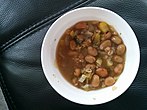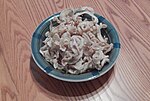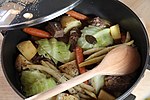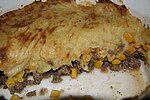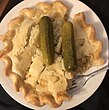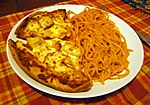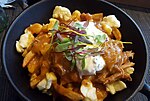Cuisine of Quebec
You can help expand this article with text translated from the corresponding article in French. (April 2022) Click [show] for important translation instructions.
|

| Cuisine of Quebec |
|---|
 |
| Part of a series on |
| Canadian cuisine |
|---|
|
|
The cuisine of Québec (also called "French Canadian cuisine" or "cuisine québécoise") is a national cuisine in the Canadian province of Québec. It is also cooked by Franco-Ontarians.
Québec's cuisine descended from 17th-century French cuisine and began to develop in New France from the labour-intensive nature of colonial life, the seasonality of ingredients and the need to conserve resources. It has been influenced by the province's history of fur trading and hunting, as well as Québec's winters, soil fertility, teachings from First Nations, British cuisine, American cuisine, historical trade relations and some immigrant cuisines.
Québec is home to many unique dishes and is most famous for its poutine, tourtières, pâté chinois, pea soup, fèves au lard, cretons and desserts such as grands-pères, pouding chômeur and St. Catherine's taffy. Québec's unique dishes are the traditional fare of the holidays, as well as the temps des sucres, a time in March where families go to sugar shacks.
Québec is known for being the biggest producer of maple syrup on the planet, as 72% of the maple syrup sold in the world (and 90% sold in Canada) originates from Québec.[1] The province is also recognized for having created over 700 different kinds of cheese, some of which have won international contests.[2]
Food critic Jacob Richler wrote that Québec's cuisine is better defined than that of the rest of Canada, due to its language barrier with the dominant culture of the United States and having had more time to develop. Conversely, Québec's cuisine and Acadian cuisine have much in common due to proximity and a shared language and history.
History
[edit]The cuisine of Québec evolved from that of 17th-century Northern France. It also retains some heritage from Poitevin cuisine: many Québecois make pâté marmite; soupe aux gourganes, which is based on gourgane beans, a strain of fava bean;[3] and soups based on other legumes.[4] Charentaise chowders (chaudrées charentaises) have evolved into the quiaudes of Gaspesia[5] and the tourtes salées of Poitiers into tourtières.[6][7]
Other foods that originate from France are pot-au-feu; blood sausage (boudin); head cheese (tête fromagée); plorine sausages; ham hock stew (ragoût de pattes de cochon); rabbit stew (civet de lapin); French toast (pain perdu or pain doré); and pastries like crêpes, beignets, croquignole biscuits, and tarts. As in France, pork is the most popular meat.

From the moment they arrived in the early 17th century, French colonists always preferred their native cuisine. However, they learned some culinary techniques from the Algonquins, Atikamekw and Iroquois. The most important ones were l’acériculture (the process of harvesting maple sap and creating maple syrup), ice fishing, and boucanage (in which fish or other meat is smoked for preservation and flavour).11
Food preservation was always important in pioneer times, due to long winters and to the frequent voyages of coureurs des bois. Butter, herbs, and lard were used for seasoning and salting. Pork and fish were boucanés(smoked), while other meats and vegetables were preserved in vinegar. These techniques are still practiced today, though not for survival. As game was so plentiful, pioneers and their descendants always hunted and fished for sustenance.
By the 1670s, a substantial agrarian population had emerged in the region of Québec City, and French habits dominated. Meals almost always featured soup, bread, meat, and wine.[8] Since the climate made it difficult to grow European grapes (namely, Vitis vinifera), wines were always imported from France.[9]12
The Conquest of New France in 1760 brought some culinary changes to Québec. One of the immediate effects was the elimination of wine, as it could no longer be imported from France. Another major change was the importation of the potato, which, in only a few decades, became a staple ingredient in Québec, dethroning bread in popularity. Sugar consumption also increased. Finally, the British imported many recipes like mashed potatoes, crumble, and meat pies.

Because tensions with the young United States alleviated, the period following the Aroostook War in 1839 saw increased interaction between Québec and New England. Some recipes inspired by the cultural exchange included fèves au lard, ketchup maison, and date squares.[10]4 The socio-economic standing of French Canadians also fell to deplorable levels; the intense poverty pushed them to simplify their meals. Recipes for bouillon were now almost nothing more than warm water. Alcoholic beverages were rarely consumed, and butter was either used sparingly or absent. Some famine foods like ploye emerged during this period.
By the early 1900s, conditions had improved somewhat, though French Canadians were still poor. Most families would often eat a mix of potatoes and pork on their plate, which is still a staple combination today. During this period, the passenger pigeon, called tourte in French, also became extinct. Because this bird's meat had been used to fill the pie-like dishes known as tourtières, the tourtière recipe had to change. Farm-raised meats like beef and pork were usually chosen as the substitutes.3[11]
The Great Depression of the 1930s saw the creation of new recipes like pâté chinois ("Chinese pie") and pouding chômeur ("unemployed man's pudding") that were delicious and cost-conscious.5 Immigration after this period diversified; immigrants no longer came only from the British Isles but also from other parts of Europe. Jewish specialties like bagels and Eastern Europe-style smoked meat became popular, resulting in the creation of Montréal-style smoked meat and Montréal-style bagels.17
The 1950s saw many changes in the eating habits of the Québécois for a variety of reasons: the popularity of fast-food grew enormously, raw milk was banned, and many fruits and vegetables became available year-round thanks to refrigerators and larger supply chains. As a result, the homemade pain de ménage was replaced with store-bought sandwich bread6; many old cheese recipes were abandoned and new ones created; and spaghetti, pizza, turkey, bacon, sausages, industrial cheeses, hamburgers, hot dogs, french fries, coleslaw and lobster rolls all become popular.
In the late 1950s, these changes brought about the creation of poutine—arguably the most famous Québécois dish—as well as other dishes, like hot chicken and guédilles.
The Quiet Revolution of the 1960s to 1970s greatly improved the socio-economic standing of French Canadians. This allowed them to have a more diverse diet. It also set the stage for high-quality products to be created in Québec and for the emergence of Québécois restaurants, for example Lafleur, Valentine, La Belle Province or St-Hubert.
From the 1980s to today, a desire for higher quality foods, more spending power, and an influence by immigrants from Europe —particularly Italy, Greece, France and Portugal— has led to the rise of the creation and production of high-quality cheeses and alcoholic beverages across Québec, as well as a return to recipes of the terroir.13 Immigration from Greece has popularized gyros and brought about slouvaki pitas.[12] Immigrants from Lebanon have popularized shawarmas which has created shish taouk.[13] Finally, NAFTA and the new culture of Quebecers vacationing south has resulted in the adoption of Western-style sushi and Tex-Mex dishes like nachos, fajitas, salsa, chili and burritos.[14][15]
Ingredients
[edit]Game, seafood, and fish
[edit]Historical poverty led many families in Québec to hunt for food until the mid 20th century.19 Tourtières were stuffed with the meat of the tourte, or passenger pigeon, which used to be common and easy prey. But, by the early 20th century, the passenger pigeon became extinct due to overhunting, deforestation, and the Allee effect.11 Families had to replace the meat with whatever they had. As a result, most modern tourtières are filled with beef or pork.
Today, the consumption of game remains a tradition, although game is not sold in grocery stores. When available, Québécois eat meat from moose, deer, hares, ruffed grouse, wild turkey, waterfowl and more rather than that of livestock.[16] Game is also sometimes given as a gift.

As for seafood, lobster and crab are caught in Gaspesia, la Côte-Nord, and the Magdalen Islands to be sold to the rest of Québec. Shrimp is often marketed as crevette de Matane after the shrimp-processing factory in the town of Matane. However, the shrimp themselves are caught in several villages on the Saint Lawrence River estuary. Mussels, oysters, scallops, and whelks (bourgots) are also caught.[17]
Salmon and trout are the most popular fish in Québec. The brook trout is nearly ubiquitous, salmon is farmed and can be caught in 118 different rivers, and Arctic char is present across nearly 100 lakes.[18] Other fished species include lake trout, yellow perch, walleye, muskellunge, Northern pike, micropterus, rainbow smelt, Greenland halibut, mackerel, lake sturgeon, lake whitefish, Atlantic cod (Eastern Québec), Atlantic herring (Eastern Québec), American eel (between Trois-Rivières and Cap-Chat), ouananiche (a kind of freshwater salmon; Lac Saint-Jean),2 frostfish (Sainte-Anne-de-la-Pérade), deepwater redfish (Saguenay fjords), capelin (coastal villages), and brown bullhead (Îles de Sorel).
Sainte-Anne-de-la-Pérade holds a world-renowned festival every December to February called La pêche des petits poisons des chenaux, where ice fishers catch tomcods. Historically, starving French colonists learned ice fishing techniques from the Atikamekw—a privilege, as the technique was kept a secret from neighbouring First Nations.
Livestock
[edit]Pork is the meat used most often in Québécois recipes. Beef is also commonly used but has been losing popularity in recent years. In summer, beef commonly features in barbecues.
Québécois pigs are mostly hybrids of the Duroc, Yorkshire, and American Landrace breeds.[19] The cattle are also hybrids of many breeds; the Aberdeen Angus, Charolais, and Limousin are the most common.[20] Despite the large cattle population, Québec imports most of its beef from the Canadian West, using its own cattle mostly for dairy. Milk production is dominated by the Holstein, but Jersey or Brown Swiss cows are also milked.[21]
Poultry is commonly consumed. Chicken is the most popular by far, but turkey and duck are also consumed.[22] Chicken eggs are very popular and mostly used at breakfast and to make pastries. Turkey is traditionally served at Christmas and Thanksgiving with croutons and sage.[23] The Estrie region has produced duck since the early 20th century. Québec is also the only producer of foie gras in Canada, as well as its largest producer in North America.[24]
Horse is eaten marginally- by less than 1% of Quebecois. Its consumption is considered taboo, though it is not illegal.[25]
Other meats include lamb, veal, rabbit, bison, elk and frog legs (from American bullfrogs and leopard frogs).[26][27]
Spices, sweeteners and cereals
[edit]Spices common in traditional recipes are linked to local production and historical commerce: salt, savory, cloves, cinnamon, parsley, thyme, sage, nutmeg, quatres épices, chives, garlic, oregano and bay leaf.411 Thanks to globalisation, a wider selection of international spices are available today, like turmeric, curry powder, allspice, cumin, cayenne pepper, etc. In recent years, chefs have attempted to create excitement for the flavours of the boreal forest; among them are green alder pepper, sweetfern, caraway seed, sweetgale, and juniper berry.

The types of sugar used are white sugar, brown sugar and maple sugar. Maple syrup is used to sweeten breakfasts, meats, and pastries. Honey is almost exclusively used for desserts, but it is also used as toast spread. Molasses and raisins are common ingredients in traditional recipes because of historical commerce with the Antilles and Brazil.11
Traditional and most common cereals are wheat, rice, oat and buckwheat.[28] Buckwheat became popular because it could grow well on the Canadian Shield.1 Nowadays, a few other cereals have managed to gain a small presence: quinoa, wild rice, chia seeds, and barley.
Fruits and vegetables
[edit]The most commonly used vegetables in traditional Québécois cuisine were those that can easily be preserved to last throughout the winter, either kept in a cool storage area like a root cellar or brined in jars. These vegetables are potato, onion, carrot, beet, pumpkin, squash (butternut, spaghetti, accorn, etc.), zucchini, beans, cabbage, turnip, and corn. In modern times, Québécois also cook with store-bought tomato, bell pepper, cucumber, lettuce, asparagus, cauliflower, broccoli, avocado, microgreens, radish, shallot, spinach, parsnip, eggplant, artichoke, kale, leek, rutabaga, sweet potato, celery, lentil, peanut, soybean, chickpea and others. Rhubarb is typically grown in backyard gardens. Fiddleheads are gathered from the wild in the spring.
Frequently eaten berries are the blueberry,2 strawberry, raspberry, blackberry, grape, cherry and cranberry.[29][30] The goldenberry is uncommonly imported from South America. Cloudberries only grow in the wilds of the boreal forest, but are still gathered seasonally in northern communities. Finally, as these plants were banned on the continent in the early 20th century and were, with time, forgotten, all types of gooseberries or currants are virtually unknown to Quebecers.[31][32]
Other important locally-grown fruits are the apple, pear, plum, cantaloupe and watermelon.[33][34] The most eaten imported fruits are: banana, orange, lemon, lime, kiwi, coconut, mango, clementine and pineapple. Other imported -but less popular- fruits include: pomegranate, grapefruit, starfruit, papaya, dragonfruit, passionfruit, fig and others.
Mushrooms have long been absent from Québec's traditional cuisine. However, they are present now, and almost always of the cremini variety. In recent years, morchella, chanterelle, shiitake and enokis mushrooms have also gained a small presence.[35]
Examples of unique dishes
[edit]Entrées or sides
[edit]- Betteraves marinées—pickled beets[36]
- Cretons—forcemeat-style pork spread containing onions and spices[37]
- Fèves au lard—beans slow-cooked with bacon and maple syrup
- Ketchup maison—green or red sauce made with sugar, vinegar, tomatoes, onions, apples and spices
- Soupe aux gourganes—soup showcasing the traditional gourgane bean[38]
- Soupe à l'orge perlé—soup showcasing pearl barley[39]
- Soupe aux pois—soup showcasing peas[40]
- Oreilles de crisse—a dish consisting of deep-fried salted fatback[41]
- Quiaude—a chowder that uses white fish[42]
-
Soupe aux gourganes.
-
Quiaude made with Greenland halibut.
-
Oreilles de crisse in a bowl.
-
Breakfast with fèves au lard in a small bowl as a side.
Main course
[edit]- Bouilli de légumes —a bouillon of traditional ingredients and spices
- Chiard—pork stew with potatoes and onions[43]
- Cigares au chou—ground beef cabbage rolls with a homemade ketchup or tomato sauce coating
- Coquille Saint-Jacques —seafood chowder surrounded by mashed potatoes and covered with cheese[44]
- Feuilleté jambon-fromage—rolled-up pastries with ham and cheese in the middle, looks like cinnamon buns[45]
- Galette aux patates—potato pancake
- Gibelotte de Sorel—soup made with a tomato base, several vegetables and white fish, dish originally from Sorel-Tracy[46]
- Guédille—lobster roll on a hotdog bun, can use other seafood instead of lobster
- Hot chicken—a chicken sandwich with gravy and peas served on top[47]
- Pâté chinois—pâté consisting of a layer of ground beef at the bottom, either whole kernel or creamed corn in the centre and mashed potatoes on top
- Pizza-ghetti— a combination meal commonly found in fast food or family restaurants, another variety is the Pizza-caesar[48][49]
- Pot-au-feu de la récolte—pork or beef pot-au-feu with traditional vegetables (ex. carrots, cabbage, etc.)[50]
- Poulet chasseur—floured chicken cooked with certain vegetables and tomato sauce[51]
- Poutine—french fries topped with cold or room temperature cheese curds and hot gravy, the most famous Québécois dish
- Poutine variants—variations on the classic poutine
- Ragoût de boulettes—a type of complex meatball ragoût
- Ragoût de pattes de cochon—a type of complex ragoût made using pig feet
- Tête fromagée—a solid structure made from a mix of pork, spices, onions, carrots and celery
- Souvlaki pita—the Québec version of the Gyros or Nova Scotian donair, largely inspired by 20th century Greek immigrants[52] and today popular in many pizzerias and patateries
- Tourtière—pie usually made with minced pork or beef, a signature dish of the temps des fêtes
- Tourtière du Lac-Saint-Jean—a type of tourtière made with a thicker crust and with cubes of potatoes, meats and broth
-
Bouilli de légumes, also called Bouilli Québécois.
-
Pâté chinois is often eaten with ketchup.
-
Traditional pâté au saumon with pickles.
-
Quebec-style souvlaki pita (comparable to the Nova Scotian donair).
-
A Quebec-style "hot chicken", topped with green peas.
-
"Pizza-ghetti", a staple in many family restaurants and diners.
-
Mix of ragoût de boulettes and ragoût de pattes de cochon with mashed potatoes.
-
Gibelotte de Sorel is a soup eaten as a meal.
Desserts
[edit]- Beigne à l'ancienne—old-fashioned doughnuts
- Beigne aux patates—potato doughnuts
- Bonbons aux patates—potato candy[53]
- Bûche de Noël—Yule log
- Galette à la mélasse—molasses cookies[54]
- Gâteau Reine Élisabeth—type of cake made with dates, walnuts and coconut icing[55]
- Gâteau au pain d'épices—cake made with certain spices[56]
- Grands-pères—wrinkly ball-shaped cake often covered with maple syrup or stuffed with a fruit-based filling
- Pets de sœurs—rolled-up pastry with a brown sugar filling, looks like cinnamon buns
- Pouding chomeur—white cake laying in a maple-syrup based pudding
- Queue de castor—oval-shaped fried dough covered in a sweet garnish
- Sucre à la crème—cubes of sugar, cream and brown sugar, similar to Scottish tablets
- Tarte à la ferlouche—pie made with raisins, molasses and brown sugar
- Tarte au sucre—pie made from a sugar-based filling[57]
- Tarte au suif—pie made from a sweet beef-fat based filling[58]
- Tire de la Sainte-Catherine—a kind of sweet taffy, created to celebrate the Saint Catherine of Alexandria
- Tire sur neige—boiling maple sap laid on snow and rolled up on a popsicle stick
- Trottoir—strawberry or blueberry-based pie whose upper crust has a pattern of rhombus-shaped holes[59]
-
Pouding-chômeur was created during the Great Depression.
-
Sucre à la crème squares are eaten as a dessert or as a treat.
Drinks
[edit]- Bière d'épinette—spruce beer
- Ice cider
- Ice wine
- Caribou—drink made from red wine, a spirit and maple syrup
Fast food
[edit]
The idea of fast food was quietly introduced to Quebec from the United States during the early 20th century. At first, it was sold from food trucks or carts pulled by horses who would park next to factories to sell quick cheap meals to factory workers. They were called "casse-croutes" or "cantines" and run by local entrepreneurs. They would usually only sell a few items, like fries and hot-dogs. In 1940, there were around 200 of these mobile distributors around Montreal factories. Cantines as actual restaurants began to appear in the 1930s. These had wider menus serving fast food staples like hamburgers, hot-dogs, fries and club sandwiches, alongside some traditional meals like pea soup, pouding chômeur, etc.[60][61]
Following the Second World War, the popularity of fast food grew enormously, aided by the rise of the automobile. [61] The post-war years also saw the popularization of pizzerias serving American pizzas,[62] chicken rotisseries, and breakfast restaurants serving English breakfasts.[63]
Quebecois tastes popularized certain techniques or foods that are not found or are uncommon in the rest of North America. For example, steamed hot dogs ("steamies") are popular here, and it's the norm to ask customers for their cooking preference. Steamies are usually topped with coleslaw, sweet yellow mustard, onion and/or sweet relish, but topping options can be more expansive.[64] Another example is that the typical American industrial gravy is not used, instead brown gravy is favored, which is made from dehydrated chicken and beef along with spices, animal fat and vinegar. A lightly spiced chicken stock is also used and called "sauce barbecue". These were made to cover French fries (known as frite-sauce) and dishes such as hot chicken (chicken between two slices of bread covered with peas) or hot hamburger (an untopped hamburger covered with sauce and peas). Brown gravy also came to be used in Quebec's most emblematic fast-food dish poutine when it was invented.[65]
Casse-croutes are still very common today (in 2016, there were over 1400[66]), but they now also compete with large chains from the US and native chains from Quebec like Valentine, La Belle Province, Ashton, Saint-Hubert, etc.[67] Nowadays, foods usually served in Quebec fast-food establishments include: poutine and its variants, steamies, Michigan hot dog,[68][69] pain à la viande (onions and ground meat on a hot-dog bun),[70] frites-sauce, hot chicken, hot hamburger, hamburgers, pogos, onion rings, fries, coleslaw, spaghetti, caesar salad, pizza and its variants, the combination meals of pizza-ghetti and pizza-caesar, sandwiches, submarine sandwiches, club sandwiches, Montreal smoked meat sandwiches and platters,[71] shawarmas and a Quebec variant called shish taouk, gyros and the Quebec exclusive souvlaki pita, roasted chicken, chicken fingers, lasagna, mac n cheese, grilled cheese[72][73], fish n chip, guedilles (lobster roll), cheese sticks, chicken wings, ice cream, and finally soft drinks.[citation needed]
Poutine variants
[edit]The classic Poutine is composed of fresh French fries and fresh cheese curds topped with hot brown gravy in a shallow bowl. The cheese curds are usually at room temperature to prevent them from melting and losing their elasticity or "squeakiness". Poutine emerged in the Centre-du-Québec area in the late 1950s. Its precise origins are uncertain as there are several cities and towns claiming to have invented the dish.
For many years, it was perceived negatively by English Canadians and mocked in English Canada.20 It was even used by some to stigmatize Québec society. But, it later became celebrated as a symbol of Québécois culture and the province of Québec. It has long been associated with Québec cuisine, and its rise in prominence has led to its popularity in the rest of Canada, in the northern United States, and internationally. Poutine has been called "Canada's national dish" though many believe this is cultural appropriation of Québécois and Québec's national identity, especially since Canada has mocked Québec for it, in the not-so-distant past. 2016
Because variants on the classic poutine have become widespread, many now consider poutine to be a dish class of its own. Some of the most commonly seen variants include: chicken poutine (chicken is added), hot dog poutine (hot dog is added), pulled pork poutine (pulled pork is added), smoked meat poutine (Montréal smoked meat is added), galvaude poutine (adds peas and turkey, and is associated with maritime Québec), all-dressed poutine (adds ingredients to imitate an all-dressed pizza), "Italian" poutine (which replaces gravy with bolognese sauce), and lobster poutine (lobster is added and gravy is substituted). Menus who list variants on the classic poutine can vary wildly between restaurants. Establishments who specialise in poutines usually offer many variants and are called poutineries.[74][75][76]
-
A classic poutine served in a cast-iron skillet.
-
A pulled pork poutine.
-
A hot dog poutine.
-
A galvaude poutine.
-
An all-dressed poutine.
-
A breakfast poutine with hollandaise sauce and bacon.
-
This poutine is named after Samuel de Champlain.
-
This poutine is sold as a cure to hangovers.
Cheeses
[edit]When Canada was part of the French Empire, colonials used their Canadienne cattle to create a variety of soft, semi-soft and soft-ripened cheeses to eat.[77] Following the Conquest of New France, the British began importing hard cheeses like Cheddar.15
In the 1960s, the banning of crude milk made most of the old cheese-making techniques and recipes, which up to that point had been successfully passed on for centuries, disappear and become forgotten. Only a few recipes remain. The Saint-Pierre, produced on l'île d’Orléans, has the honour of being the oldest North American cheese. It is a soft-ripened cheese sold under the forms of la Faisselle, le Paillasson or le Raffiné.[78][79][80] The Cailles cheese, a cheese made from fermented milk and typically used in salads, also used to be quite widespread. It now only exists in the Charlevoix and Saguenay-Lac-Saint-Jean regions. Nowadays, there are attempts to diversify the ways in which Cailles is consumed.[81]
There are some cheeses that were created by priests. Towards the end of the 19th century, a group of trappist monks were expelled from France and moved to Oka. One of them, who originated from Notre-Dame-du-Port-du-Salut, created a paste which was eventually used to mold the first Oka cheese. Benedictines were responsible for creating l’Ermite, a blue cheese, in 1943 at Saint-Benoît-du-Lac.[82]
Today, Québec creates over 700 different kinds of cheeses and is the biggest cheese producer in Canada.[83] Québecers enjoy many natively produced and imported hard cheeses, including hard cheeses flavored with beer or wine. Most soft cheeses are produced locally and many are artisanal.
-
The Paillasson. It is eaten grilled and is often paired with maple syrup.
-
Oka cheese is now made in large factories.
-
Pied-De-Vent cheese is made from the milk of Canadienne cattle.
-
The Pikauba was created in 2005 in Hébertville.
-
The Cendrillon won Best cheese in the world in the 2009 World Cheese Awards.
Maple syrup
[edit]Québec produces 72% of the maple syrup sold on Earth and 90% of the maple syrup sold in Canada.[84] Maple syrup is made from heated maple sap. The syrup is often used at breakfast to cover crêpes and pain doré, and as a component of fèves au lard. It can also be used to caramelize meats like ham, to stabilize the acidity of certain sauces, and to complement desserts. It is the main ingredient showcased in sugar shacks.16
Many maple syrup-derived products exist. Tire, French for sugar on snow, is heated maple syrup that is cast onto a flat bed of snow and then rolled up onto a Popsicle stick. Tire is very popular at sugar shacks and during springtime. Maple butter is a spread commonly used at breakfast on toast. Maple sugar can serve as a replacement to brown and white sugar.
Meat
[edit]Smoked meat
[edit]
In Québec, a technique called boucanage is sometimes used to smoke meat.
Colonials learned this technique from First Peoples. After they discovered that it was useful for preserving food, they decided to start smoking their meat in the boucanage fashion, following their usual brining and/or spicing. First Peoples, on the other hand, continued to only boucaner and never started brining or spicing.11 Today, Québecers still eat food that has been boucané for its taste.
Establishments called boucanières or boucaneries are specialized in the process. Modern boucanières can also use tree essences to infuse a certain taste in the meat, with maple wood being the most popular choice. A technique called boucaner à froid has also been developed; it involves drying fish and then suspending them over a fire.15 Boucaner à froid has always been popular in the Gaspesia, Bas-Saint-Laurent and Côte-Nord regions since fish were and are still commonly caught there.[85]
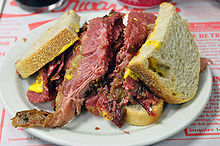
In the 1930s, Jewish immigrants came to Montréal and introduced their own Eastern European meat-smoking technique to Québec. This technique is often used today to make Montréal smoked meat, which is then often cut up in narrow slices to be added to dishes as an ingredient. Montréal smoked meat is also often spiced with Montréal steak spice and used to make Montréal smoked meat sandwiches.[86]17
Smoked salmon has become more popular in recent decades due to influence from the United States and Europe. Smoked pork's popularity has decreased11 and it is now almost exclusively consumed during Easter.18
Charcuterie
[edit]In Quebec, charcuterie is sometimes referred to as cochonailles. It includes:
- Creton is composed of ground pork, lard, milk and cereal that is cooked together to obtain a creamy paste. Cretons are often eaten as a snack or for breakfast on roasted bread pieces called rôties. If another kind of meat is used to create cretons, like poultry or veal, it is called cretonnade instead.
- Tête fromagée is less popular but used in the same way as cretons.
- The boudin of Québec is made of lard, milk, onions and pork blood. It is served in a pan along with a sweet side or a sauce. Since 2018, the Goûte-Boudin de Boucherville association hands out a yearly prize for the best boudin.[87]
- Plorines are composed of lard and flavoured meat enveloped in pork caul fat. Sometimes plorine recipes can also include eggs, beef and/or bread.
- Oreilles de Christ are lard pieces that are fried until crispy. They are eaten as an amuse-gueule and sometimes with maple syrup.
Pastries
[edit]
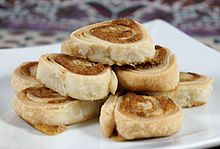
Here are some pastries popular in Quebec:
- Crêpes and pancakes are popular breakfast items. They are often served with maple syrup and/or fruits.5
- Doughnuts. The doughnut holes are eaten as well with powdered sugar or icing on top.
- Pies. The most popular kinds are sugar-based, like tarte au sucre, or fruit-based, like blueberry, apple, strawberry, or raspberry.
- Cakes. Popular kinds include carrot cake and chocolate cake.
- Sucre à la crème is a fudge-like sweet.
- Pets-de-sœur and cinnamon rolls are both popular and spiral-shapped.
- Chocolatines consist of small croissants with chocolate inside.
- Pouding chomeur is a white cake soaked in maple syrup or brown sugar.
- Grands-pères, a spherical cake that is eaten plain, with maple syrup, or filled with fruits.5
- Éclairs, an oblong pastry stuffed with cream and topped with chocolate.
- Macarons are a sandwich-shaped meringue-based sweet.
- Mille-feuilles are a layered puff pastry.
- Croquignoles are braided, twisted or rectangular fried dough pastries. They may be found in rural regions.11
Regional foods
[edit]Some regions of Québec are known for specific foods or products. Montréal is known for having created Montréal-style smoked meat, Montréal-style bagels, Montréal hot dogs (also called "steamies"), and Montréal melons. The Saguenay-Lac-Saint-Jean region is the birthplace of the tourtière du Lac-Saint-Jean, soupe aux gourganes and Saguenay Dry.
Maritime Quebec, known for its fish and seafood, is a region where cipaille is consumed during the holidays.[88] Pot-en-pot des îles de la Madeleine is a dish of the Magdellan Islands.[89]
Some municipalities are associated with high-quality meat, such as duck from lake Brome[90] or Charlevoix lamb.
Strains and breeds
[edit]Strains
[edit]Over the centuries, new strains of fruits and vegetables were created in Québec. Then, in the 1900s, people moved away from a farming lifestyle. As a result, most of these have been lost.[91] Here are some that have been preserved or rediscovered:
- The Montréal melon
- The Oka melon[92][93]
- White Canadian corn[94]
- The crotte-d’ours potato of Louis-Marie[95]
- The Thibodeau bean of Saint-Jules[96]
- The pomme Fameuse[97]
- The Mémé tomato of Beauce[98]
- The potato onion[99]
Breeds
[edit]Though few in number now, these breeds are still used today:
References
[edit]Sources
[edit]- ^ «Producteurs et productrices acéricoles du Québec" (consulted 2020-04-14)
- ^ "Le Québec est le plus grand producteur de fromage au Canada" (consulted 2020-04-07)
- ^ "Le pâté marmite à l'ancienne – Le farci Poitevin". lefarci-poitevin.fr. Archived from the original on 2020-04-06. Retrieved 2020-04-06.
- ^ "La soupe aux fèves". yves.huot-marchand.pagesperso-orange.fr. Retrieved 2020-04-06.
- ^ "Quand Alma préparait sa "kiaude"" (PDF) (in French). July–October 2016. Retrieved 7 April 2020.
- ^ "La tourtière poitevine au poulet". France Bleu (in French). 2015-08-27. Retrieved 2020-04-06.
- ^ "tourtiere de paques". creonsaufildessaisons.e-monsite.com (in French). Retrieved 2020-04-06.
- ^ "Alimentation | Musée virtuel de la Nouvelle France". Retrieved 2020-04-06.
- ^ "De la qualité des vins en Nouvelle-France" (PDF) (in French). Winter 1992. Retrieved 7 April 2020.
- ^ "Les carrés divers | Le Québec Cuisine". www.quebecuisine.ca. Retrieved 2020-04-07.
- ^ "Pleins feux sur... la tourte voyageuse, une espèce disparue, et la tourtière, un mets bien connu!". Ministère des Forêts, de la Faune et des Parcs (in French). Retrieved 2023-09-14.
- ^ "Greek Immigration to Montreal in the 50s and 60s - Park Extension Historical Society / Société d'histoire de Parc-Extension".
- ^ "Les meilleurs spots pour manger des shish taouks à Québec". WKND. Retrieved 13 September 2023.
- ^ "L'histoire du sushi qui a plus d'un tour dans son rouleau! | Sushi Shop" (in Canadian French). 2 April 2021. Retrieved 13 September 2023.
- ^ "La cuisine tex-mex". www.hrimag.com (in French). Retrieved 13 September 2023.
- ^ "Règles de chasse par gibier". Gouvernement du Québec (in French). Retrieved 15 September 2023.
- ^ "The bourgot snail" (consulted 2020-09-17)
- ^ "Liste des rivières à saumon" Archived 2018-12-28 at the Wayback Machine (consulted 2020-11-01)
- ^ "Les principales races de porc au Québec" (consulted 2020-09-16)
- ^ "Les races de bœuf au Québec" (consulted 2020-09-16)
- ^ "La sacrée vache" (consulted 2020-09-16)
- ^ "Le poulet au Québec" (consulted 2020-09-16)
- ^ "Christmas Turkey" (consulted 2020-09-17)
- ^ [Des produits Rougié made in Canada |url=https://www.reussir.fr/volailles/des-produits-rougie-made-canada "Une filière foie gras complète"] (consulted 2020-09-16)
- ^ "Manger de la viande chevaline, un tabou qui persiste" (consulted 2020-09-16)
- ^ "Nos viandes, volailles et gibier | Metro". www.metro.ca (in French). Retrieved 14 September 2023.
- ^ "CHASSE À LA GRENOUILLE ET AU OUAOUARON" (consulted 2020-09-28)
- ^ "Épices et herbes de chez nous" (consulted 2020-09-17)
- ^ "Au pays de la canneberge" (consulted 2020-09-16)
- ^ site=La Terre de Chez Nous "Le Québec, premier au pays en fruits et petits fruits" (consulted 2020-09-16)
- ^ "🔊 Black Currants: A Once-Forbidden Fruit | Savanna Institute". www.savannainstitute.org. Retrieved 2023-09-13.
- ^ "Cassis du Québec (Canada) : La petite baie à la grande Histoire" (consulted 2020-09-16)
- ^ "Le temps des prunes" (consulted 2020-09-16)
- ^ "Auto-Cueillette - Cultures – Poire" (consulted 2020-09-16)
- ^ "L'Opération morille" (consulted 2020-09-17)
- ^ "Betteraves marinées", www.recettes.qc.ca (consulted April 23rd 2019).
- ^ "Cretons" (consulted October 28th 2020)
- ^ "Fava bean soup" (consulted October 28th 2020)
- ^ "Pearl barley soup" (consulted October 28th 2020)
- ^ "Pea soup" (consulted October 28th 2020)
- ^ "Oreilles de crisse" (consulted October 28th 2020).
- ^ "Les quiaudes, chaudrées et chowders. | Le Québec Cuisine". www.quebecuisine.ca.
- ^ "Chiard de porc", www.recettes.qc.ca (consulted 23 April 2019).
- ^ "Coquille Saint-Jacques". Lisette gourmande (in French). 29 January 2011.
- ^ "Roulés feuilletés jambon-fromage".
- ^ "Recette de gibelotte" Archived 2017-06-28 at the Wayback Machine, www.festivalgibelotte.qc.ca(consulted 23 April 2019).
- ^ "Hot chicken de survie", cuisinez.telequebec.tv (consulted 23 April 2019).
- ^ "Pizza-Ghetti! What Is Pizza-Ghetti? How To Make A Wood Fired Pizza-Ghetti?". Il Fornino, New York. Retrieved 31 March 2020.
- ^ Pizza-ghetti Archived 2010-07-24 at the Wayback Machine: a staple item on fast-food menus in Montreal
- ^ "Pot-au-feu de la récolte" Archived 2019-04-23 at the Wayback Machine, www.lecourrierdusud.ca (consulted 23 April 2019).
- ^ "Poulet chasseur"(consulted 2020-11-08)
- ^ "Greek Immigration to Montreal in the 50s and 60s - Park Extension Historical Society / Société d'histoire de Parc-Extension".
- ^ "Le blogue des "Bleuets du Lac Saint-Jean": Les bonbons aux patates.....la recette". 20 November 2012.
- ^ "Galettes à la mélasse moelleuses à l'ancienne". November 2014.
- ^ "Gâteau Reine Élisabeth", www.recettes.qc.ca (consulted 23 April 2019).
- ^ "Gâteau au pain d'épices".
- ^ "Tarte au sucre classique".
- ^ "Recette traditionnelle de tarte au suif" Archived 2019-04-23 at the Wayback Machine, www.gratuit.ca (consulted 23 April 2019).
- ^ "Trottoirs aux fraises à ma façon", www.recettes.qc.ca (consulted 22 April 2019).
- ^ Radio-Canada, Médias numériques de. "L'histoire des cantines au Québec : des patateries aux casse-croûtes revisités | Mordu". Radio-Canada (in Canadian French). Retrieved 2024-07-29.
- ^ a b ICI.Radio-Canada.ca, Zone Alimentation- (2 July 2020). "Les 3 cabanes à patates préférées des Mauriciens et Centricois". Radio-Canada (in Canadian French). Retrieved 29 July 2024.
- ^ "L'étonnante histoire de la pizza | Saputo Services Alimentaires". www.saputofoodservice.ca (in French). Retrieved 2024-07-29.
- ^ Pâris, Marie (13 April 2018). "Ode à la cantine". Voir.ca (in Canadian French). Retrieved 29 July 2024.
- ^ Siciliano-Rosen, Laura. "Steamie in Montreal". Eat Your World. Retrieved 29 July 2024.
- ^ "Sauce brune". Gastronomiac (in French). Retrieved 29 July 2024.
- ^ "Les casse-croûte en chiffres". La Presse+ (in French). 27 May 2019. Retrieved 29 July 2024.
- ^ Journal, Le (2021-07-05). "Le baromètre des restaurants rapides préférés des Québécois". Le Journal de Montréal. Retrieved 2024-07-29.
- ^ Belzile, Gabriel (2022-09-09). "La Sainte Trinité du hot-dog Michigan". Tastet (in Canadian French). Retrieved 2024-07-29.
- ^ Guy, Chantal (2022-05-06). "L'adieu au hot-dog (Michigan) de Chez Philippe". La Presse (in Canadian French). Retrieved 2024-07-29.
- ^ "Pains à la viande (comme chez Ashton) | Bon pour toi : Bon pour toi". bonpourtoi.ca (in French). Retrieved 2024-07-29.
- ^ Lee, Jason (8 February 2018). "Tout ce que vous devez savoir sur le smoked meat". Tourisme Montréal (in French). Retrieved 29 July 2024.
- ^ "Menu Casse-Croûte | Restaurant à Trois-Rivières". Casse-croûte Courteau (in Canadian French). Retrieved 2025-01-19.
- ^ "Casse-croûte | Restaurant Jeannot". www.restaurantjeannot.ca. Retrieved 2025-01-19.
- ^ "Poutine | l'Encyclopédie Canadienne". www.thecanadianencyclopedia.ca.
- ^ "L'histoire de la poutine". L'Académie (in Canadian French). 10 February 2017.
- ^ "poutine | food | Britannica". www.britannica.com.
- ^ "Fromages d’ici" (consulted 2020-04-07)
- ^ "Un fromage de plus de 125 ans" (consulted 2020-04-07)
- ^ "Le fromage de l'Île d'Orléans est sauvé" (consulted 2020-04-07)
- ^ "Les Fromages de l'île d'Orléans" (consulted 2020-04-07)
- ^ "Le fromage en grains ou en crottes" (consulted 2020-04-07)
- ^ "Cheeses of Quebec" (consulted 2020-04-07)
- ^ "Le Québec est le plus grand producteur de fromage au Canada" (consulted 2020-04-07)
- ^ «Producteurs et productrices acéricoles du Québec" (consulted 2020-04-14)
- ^ "Fumage du poisson au Québec" (consulted 2020-04-09)
- ^ "History of Smoked Meat in Quebec" (consulted 2020-04-09)
- ^ "Association Québécoise du Goûte-Boudin de Boucherville – Faire connaître le boudain" (consulted 2020-04-09)
- ^ "Matane, destination gourmande de la crevette", www.tourisme-gaspesie.com (consulted 23 April 2019).
- ^ "Pot-en-pot des îles de la Madeleine". Ricardo (in French).
- ^ Site officiel, canardsdulacbrome.com (consulted 23 April 2019).
- ^ "Gardiens de semences". 2019-05-13. Retrieved 2020-09-16.
- ^ "Oka melon (Cucumis melo)". Terre promise. Retrieved 2025-01-19.
- ^ Dumas, Ève (2017-10-23). "Le melon d'Oka, une variété à découvrir". La Presse (in Canadian French). Retrieved 2025-01-19.
- ^ "Le maïs canadien blanc". 8 February 2017. Retrieved 2020-10-29.
- ^ "La patate crotte-d'ours de Louis-Marie". 30 June 2017. Retrieved 2020-10-29.
- ^ "The Thibodeau beans of Saint-Jules". 7 July 2016. Retrieved 2020-10-29.
- ^ "La pomme Fameuse". 2 November 2011. Retrieved 2020-10-29.
- ^ "Mémé tomato". 2 November 2011. Retrieved 2020-10-29.
- ^ "The potato onion". 22 April 2015. Retrieved 2020-10-29.
Bibliography
[edit]- ^ Anita Steward, Great Canadian Cuisine, Vancouver, Douglas & McIntyre, 1999, 192p.
- ^ Cécile Roland Bouchard, L'Art culinaire au pays des bleuets et de la ouananiche, La Fondation culinaire régionale Saguenay-Lac-St-Jean, 1967, 245 p.
- ^ Cercle de fermières de Cowansville, 100 recettes d'antan, Cowansville, Le Cercle, 1976, 112 p.
- ^ Couillard, Suzette and Normand, Best Québec Recipes of Bygone Days , L'Islet: Éditions Suzette Couillard, 2002, 367 p. (ISBN 978-2-920368-06-4).
- ^ Émilienne Walker-Gagné, La Cuisine de mes grand'mères. Recettes d'autrefois, Montréal, Grandes éditions du Québec, 1974, 186 p.
- ^ Gertrude Larouche, 350 ans au coin du four, 1989, 177 p. (ISBN 978-2-9801430-0-7).
- ^ Hélène-Andrée Bizier, Cuisine traditionnelle des régions du Québec, Éditions de l'Homme, 1996 (ISBN 978-2-7619-1347-8).
- ^ Hélène-Andrée Bizier and Robert-Lionel Séguin, Le Menu quotidien en Nouvelle-France, Art global, 2004, 124 p. (ISBN 978-2-920718-92-0).
- ^ Jacques Dorion, Le Québec en 101 saveurs. Historique des terroirs, produits des régions, recettes, meilleures adresses, Outremont, Trécarré, 2001, 144 p. (ISBN 978-2-89249-976-6).
- ^ Jacques Dorion, Saveurs des campagnes du Québec. La route des délices du terroir, Montréal, Éditions de l'Homme, 1997, 214 p. (ISBN 978-2-7619-1351-5).
- ^ Jean-Marie Francœur, Encyclopédie de la cuisine de Nouvelle-France (1606-1763). Histoires, produits et recettes de notre patrimoine culinaire, Anjou (Québec), Fides, 2015, 590 p. (ISBN 978-2-7621-3922-8, OCLC 914400153).
- ^ Jean-Marie Francœur, Genèse de la cuisine québécoise. À travers ses grandes et ses petites histoires, Anjou, Québec, Fides, 2011 (ISBN 978-2-7621-3029-4).
- ^ Jean-Paul Grappe, La Cuisine traditionnelle du Québec. Découvrez la cuisine de nos régions, Montréal, ITHQ-Éditions de l'Homme, 2006, 396 p. (ISBN 978-2-7619-2300-2).
- ^ Julian Armstrong, A Taste of Québec. Second Edition, Toronto: Macmillan, 2001, 214 p. (ISBN 978-1-55335-005-7)
- ^ Julian Armstrong, Au goût du Québec, Saint-Laurent, Éditions du Trécarré, 1992, 218 p. (ISBN 978-2-89249-416-7).
- ^ Ken Haedrich et Suzanne P. Leclerc, Le Temps des sucres. 130 recettes à l'érable, Montréal, Éditions de l'Homme, 2003, 142 p. (ISBN 978-2-7619-1729-2).
- ^ Lise Blouin, L'Alimentation traditionnelle à l'île d'Orléans, Québec, Éditions Garneau, 1977, 156 p. (ISBN 978-0-7757-2361-8).
- ^ Martin Fournier, Jardins et potagers en Nouvelle-France. Joie de vivre et patrimoine culinaire, Sillery, Septentrion, 2004, 242 p. (ISBN 978-2-89448-385-5).
- ^ Michel Lambert, Histoire de la cuisine familiale du Québec, vol. 1 : Ses origines autochtones et européennes, Québec, Les Éditions GID, 2007, 504 p. (ISBN 978-2-922668-88-9).
- ^ Michel Lambert, Histoire de la cuisine familiale du Québec, vol. 2 : La Mer, ses régions et ses produits, des origines à aujourd’hui, Québec, Les Éditions GID, 2007, 912 p. (ISBN 978-2-922668-96-4).
- ^ Michèle Serre, Les Produits du marché au Québec, Outremont, Éditions du Trécarré, 2005, 527 p. (ISBN 978-2-89568-105-2).
- ^ Micheline Mongrain-Dontigny, A Taste of Maple : History and Recipes, Saint-Irénée: Éditions La Bonne recette, 2003, 127 p. (ISBN 978-2-9804058-9-1)
- ^ Micheline Mongrain-Dontigny, Traditional Québec Cooking : A Treasure of Heirloom Recipes, La Tuque : Éditions La Bonne recette, 1995, 156 p. (ISBN 978-2-9804058-2-2)
- ^ Micheline Mongrain-Dontigny, L'Érable, son histoire, sa cuisine, Saint-Jean-sur-Richelieu, Éditions La Bonne recette, 2003, 127 p. (ISBN 978-2-9804058-8-4).
- ^ Micheline Mongrain-Dontigny, La Cuisine traditionnelle des Cantons-de-l'Est, Saint-Jean-sur-Richelieu, Éditions La Bonne recette, 2002, 188 p. (ISBN 978-2-9804058-6-0).
- ^ Micheline Mongrain-Dontigny, La Cuisine traditionnelle de Charlevoix, La Tuque, Éditions La Bonne recette, 1996, 177 p. (ISBN 978-2-9804058-3-9).
- ^ Micheline Mongrain-Dontigny, La Cuisine traditionnelle de la Mauricie. Un patrimoine culinaire à découvrir, Montréal, Éditions La Bonne recette, 1998, 181 p. (ISBN 978-2-9804058-4-6).
- ^ Olwen Woodier and Suzanne P. Leclerc (traduction de Françoise Schetagne), Le Temps du maïs. 140 succulentes recettes, Montréal, Éditions de l'Homme, 2003, 186 p. (ISBN 978-2-7619-1769-8).
- ^ Olwen Woodier and Suzanne P. Leclerc (traduction de Françoise Schetagne), Le Temps des pommes. 150 délicieuses recettes, Montréal, Éditions de l'Homme, 2002, 206 p. (ISBN 978-2-7619-1728-5).
- ^ Paul-Louis Martin, Les Fruits du Québec. Histoire et traditions des douceurs de la table, Sillery, Septentrion, 2002, 224 p. (ISBN 978-2-89448-339-8).
- Richler, Jacob (2012). My Canada Includes Foie Gras. Toronto: Viking Canada. ISBN 978-0-670-06582-0.
- ^ Richard Bizier and Roch Nadeau, Célébrer le Québec gourmand. Cuisine et saveurs du terroir, Outremont, Trécarré, 2003, 126 p. (ISBN 978-2-89568-133-5).
- ^ Richard Bizier and Roch Nadeau, Recettes traditionnelles du temps des fêtes, Outremont, Trécarré, 2006, 176 p. (ISBN 978-2-89568-338-4).
- ^ Richard Bizier and Roch Nadeau, Le Répertoire des fromages du Québec, Outremont, Trécarré, 2002, 384 p. (ISBN 978-2-89568-132-8).
- ^ Richard Trottier, Claude Morneau et Pascale Couture, La Cuisine régionale au Québec, Montréal, Éditions Ulysse, 1999, 206 p. (ISBN 978-2-89464-187-3).
- ^ Roseline Normand and Suzette Couillard, La Bonne Table d'antan, Saint-Eugène, L'Islet, Éditions S.R., 1982, 361 p. (ISBN 978-2-920368-01-9).
- ^ Roseline Normand and Suzette Couillard, Cuisine traditionnelle d'un Québec oublié, L'Islet, Québec, 1981, 326 p. (ISBN 978-2-920368-00-2).
- ^ Sœur Sainte-Marie-Vitaline, 235 recettes pour dîners et soupers. Exercices pratiques d'art culinaire, Congrégation de Notre-Dame de Montréal, 1942, 80 p.
- ^ Sœur Berthe, Les techniques culinaires, Montréal, Éditions de l'Homme, 1978, 275 p. (ISBN 0775906182).
- ^ Vincent Demester, La Cuisine des premiers migrants du Québec. Enquête sur la disparition du patrimoine culinaire du Poitou-Charentes, Paris (France), L'Harmattan, coll. « Questions alimentaires et gastronomiques », 2014, 250 p. (ISBN 978-2-343-03735-6).
Further reading
[edit]- Onishi, Norimitsu; Stuart-Ulin, Nasuna (2024-08-28). "In Quebec's Casse-Croûtes, Fast Food for a Short but Sweet Summer". The New York Times. Retrieved 2024-08-31.

